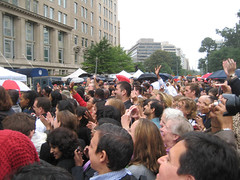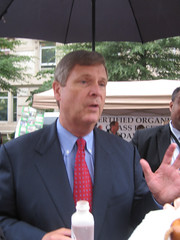The following post was submitted by Joe Cloud, partner in T&E Meats, a small-scale locally focused slaughterhouse in Harrisonburg, Va. I wrote about T&E in the WaPo and invited Joe to post his thoughts on this blog. - SF
This is usually the slowest time of the year for butchering, but T&E Meats is booked months in advance, like the other small meat processing plants in Virginia. We’re working at almost full capacity to bring locally grown, pasture-raised, and humanely slaughtered quality meats to market.
But, right now, our future is looking tenuous due to newly proposed regulations from the USDA.
Picture an hourglass and you’ll understand the local, sustainable meat crisis: there are plenty of willing consumers looking for humanely raised, quality local meats, and there are more and more farmers looking to “meat” that consumer demand (sorry – couldn’t help myself!), but the real bottle neck is processing capacity. Small, community-based meat processing plants have become an endangered species in America, done in by an ocean of super-cheap industrial meat and the challenges and costs of meeting one-size-fits-all regulations.
Although species go extinct on earth on a regular basis, every so often there is a major event that comes along and wipes out 40% or 50%. The same happens in the small business world. A few businesses fold every year due to retirement, poor management, and changes in the market, and that is quite normal. But then every so often a catastrophic event comes along that causes a wholesale wipeout.
In the small meat businesses in America, catastrophic events result from changes high up in the regulatory food chain that make it very difficult for small plants to adapt. The most recent extinction event occurred at the turn of the millennium when Small and Very Small USDA-inspected slaughter and processing plants were required to adopt the HACCP (Hazard Analysis and Critical Control Point Plan) system. It has been estimated that over 20%, perhaps more, of existing small plants went out of business when HACCP was first instituted. Now, proposed changes to HACCP threaten to take down many of the remaining local plants, making the availability of healthy, local meats a rare commodity.
This is ironic given the USDA's new emphasis on promoting local food production. The department's Know Your Farmer Know Your Food Program web site says it wants to "foster the viability and growth of small and mid-size farms and ranches, and we want to create new opportunities for farmers and ranchers by promoting locally produced foods." But the newly proposed regulations from the Food Safety and Inspection Service (FSIS), the inspection arm of the USDA, will reduce local opportunities for ranchers, never mind create new ones.
The intent of HACCP is to prevent contamination of meat by harmful pathogens. It does so by instituting well-recognized, established processes and controls set by the USDA itself. At T&E, we have had a HACCP Plan in place since 1999, and it works. We undergo extensive E.Coli testing every year, and have never had a positive sample.
But on March 19, the FSIS published a Draft Guidance on HACCP System Validation, outlining new rules which would institute much more intensive testing of all meats, whether or not a problem has been identified. These requirements will cost small plants tens of thousands of dollars, perhaps even hundreds of thousands, every year -- a financial burden appears great enough to force many to shutter.
Now, the reason these rules are being proposed is clear: millions of pounds of recalled hamburger, e. coli food poisoning incidents and distrust by consumers and foreign trading partners of U.S. produced meat. But these problems have arisen at plants that handle thousands of animals a day in extremely fast-moving production lines.
Small plants operate quite differently. At T&E, for example, we process around 20 animals a day. I know which farmer delivered each animal, often because that same farmer wants his butchered animal back so he can sell it. We're not mixing thousands of animals of unknown provenance into piles of hamburger meat and then sending it all around the country.
Perhaps a large plant slaughtering 5,000 animals per day can afford its own lab and microbiology staff, and can pass the cost along to the consumer. And perhaps they should, given the recalls arising from these large-scale facilities. But most small plants can’t handle it.
The USDA needs to recognize that "One Size Fits All" inspection no longer works. The risks arising from mega agribusiness plants are far different from community-based plants and they should be regulated appropriately. This does not mean lowering the hurdles for small processors. Rather it means tailoring regulations to the scale and risks of an operation. That way we can provide what the consumer wants – safe AND local food, not just the shrink-wrapped anonymous meat in the supermarket.
The USDA is accepting comments on this matter until June 19th, 2010. The original deadline was April 19. You can learn more at the Association of American Meat Processors web site, or the Niche Meat Processors Assistance Network.
Please submit a comment if you care about community-based meat processing and humanely produced meats. Your comments really do matter. Submit your comments to the email address DraftValidationGuideComments@fsis.usda.gov or to the Docket Clerk, USDA, FSIS, Room 2-2127, 5601 Sunnyside Avenue, Beltsville, MD 20705.







